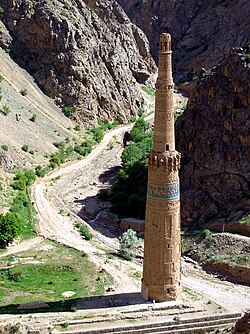Portal:Afghanistan
The Afghanistan Portal
Afghanistan, officially the Islamic Emirate of Afghanistan, is a landlocked country located at the crossroads of Central Asia and South Asia. Referred to as the Heart of Asia, it is bordered by Pakistan to the east and south, Iran to the west, Turkmenistan to the northwest, Uzbekistan to the north, Tajikistan to the northeast, and China to the northeast and east. Occupying 652,864 square kilometers (252,072 sq mi) of land, the country is predominantly mountainous with plains in the north and the southwest, which are separated by the Hindu Kush mountain range. Kabul is the country's largest city and serves as its capital. According to the World Population review, , Afghanistan's population is 43 million. The National Statistics Information Authority of Afghanistan estimated the population to be 32.9 million . Human habitation in Afghanistan dates to the Middle Paleolithic era. Popularly referred to as the graveyard of empires, the land has historically been home to various peoples and has witnessed numerous military campaigns, including those by the Persians, Alexander the Great, the Maurya Empire, Arab Muslims, the Mongols, the British, the Soviet Union, and a US-led coalition. Afghanistan also served as the source from which the Greco-Bactrians and the Mughals, amongst others, rose to form major empires. The various conquests and periods in both the Iranian and Indian cultural spheres. the area was a center for Zoroastrianism, Buddhism, Hinduism, and later Islam. The modern state of Afghanistan began with the Durrani Afghan Empire in the 18th century, although Dost Mohammad Khan is sometimes considered to be the founder of the first modern Afghan state. Dost Mohammad died in 1863, days after his last campaign to unite Afghanistan, and Afghanistan was consequently thrown back into civil war. During this time, Afghanistan became a buffer state in the Great Game between the British Empire and the Russian Empire. From India, the British attempted to subjugate Afghanistan but were repelled in the First Anglo-Afghan War. However, the Second Anglo-Afghan War saw a British victory and the successful establishment of British political influence. Following the Third Anglo-Afghan War in 1919, Afghanistan became free of foreign political hegemony, and emerged as the independent Kingdom of Afghanistan in June 1926 under Amanullah Khan. This monarchy lasted almost half a century, until Zahir Shah was overthrown in 1973, following which the Republic of Afghanistan was established. Afghanistan is rich in natural resources, including lithium, iron, zinc, and copper. It is the second largest producer of cannabis resin, and third largest of both saffron and cashmere. The country is a member of the South Asian Association for Regional Cooperation and a founding member of the Organization of Islamic Cooperation. Due to the effects of war in recent decades, the country has dealt with high levels of terrorism, poverty, and child malnutrition. Afghanistan remains among the world's least developed countries, ranking 180th in the Human Development Index. Afghanistan's gross domestic product (GDP) is $81 billion by purchasing power parity and $20.1 billion by nominal values. Per capita, its GDP is amongst the lowest of any country . (Full article...) Selected article - The Muslim conquests of Afghanistan began during the Muslim conquest of Persia as the Arab Muslims migrated eastwards to Khorasan, Sistan and Transoxiana. Fifteen years after the battle of Nahāvand in 642 AD, they controlled all Sasanian domains except in Afghanistan. Fuller Islamization was not achieved until the period between 10th and 12th centuries under Ghaznavid and Ghurid dynasties who patronized Muslim religious institutions. Khorasan and Sistan, where Zoroastrianism was well-established, were conquered. The Arabs had begun to move towards the lands east of Persia in the 7th century. The Muslim frontier in modern Afghanistan had become stabilized after the first century of the Lunar Hijri calendar as the relative importance of the Afghan areas diminished. From historical evidence, it appears Tokharistan (Bactria) was the only area conquered by Arabs where Buddhism heavily flourished. Balkh's final conquest was undertaken by Qutayba ibn Muslim in 705. (Full article...)Did you know? -
General images -The following are images from various Afghanistan-related articles on Wikipedia.
Related portalsReligions in Afghanistan Neighboring countries Other countries Selected picture - President Hamid Karzai's August 2007 visit to the United States, where he was met by George and Laura Bush at Camp David in Maryland
TopicsRecognized content
Featured articlesGood articles
Featured pictures
CategoriesNew articlesThis list was generated from these rules. Questions and feedback are always welcome! The search is being run daily with the most recent ~14 days of results. Note: Some articles may not be relevant to this project.
Rules | Match log | Results page (for watching) | Last updated: 2024-06-07 19:35 (UTC) Note: The list display can now be customized by each user. See List display personalization for details.
WikiProjects
Associated WikimediaThe following Wikimedia Foundation sister projects provide more on this subject:
External mediaSourcesDiscover Wikipedia using portals | ||||||




















































































